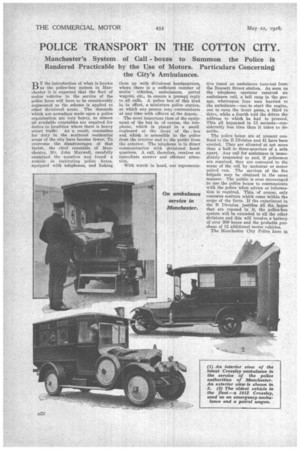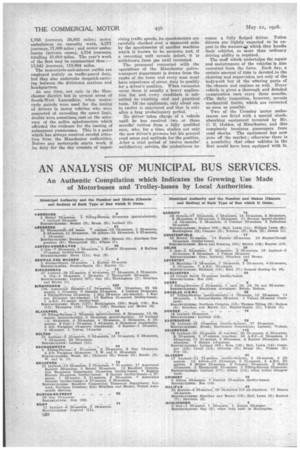POLICE TRANSPORT IN THE COTTON CITY.
Page 102

Page 103

Page 104

If you've noticed an error in this article please click here to report it so we can fix it.
Manchester's System of Call boxes to Summon the Police is Rendered Practicable by the Use of Motors. Particulars Concerning the City's Ambulances.
BY the introduction of what is known as the police-box system in Manchester it is expected that the fleet of motor vehicles in the service of the police force will have to be considerably augmented as the scheme is applied to other divisional areas. The demands which are nowadays made upon a police organization are very heavy, as almost all available constables are required for duties in localities where there is heavy street traffic. As a result, constables for duty in the scattered residential areas of the city have become fewer. To overcome the disadvantages of that factor, the chief constable of Manchester, Mr. John Maxwell, carefully examined the question and found a remedy in instituting police boxes, equipped with telephones, and linking
them up with divisional headquarters, where there is a sufficient number of motor vehicles, ambulances, patrol wagons, etc., to ensure a prompt reply to all calls. A police box of this kind is, in effect, a miniature police station, at which any person may communicate at any time with officers at the depots.
The most important item of the equipment of the box is, of course, the telephone, which is placed in a small cupboard at the front of the box and which is accessible to the police from the interior and to the public from the exterior. The telephone is in direct communication with divisional headquarters. A call, therefore, receives an immediate answer and efficient attention.
With watch in hand, our representa
tive timed an ambulance turn-out from ' the Bennett Street station. As soon as the telephone operator received an ambulance call, a bell rang in the garage, whereupon four men hurried to the ambulance—one to start the engine, one to open the front gates, a third to drive, while a fourth told the driver the address to which he had to proceed. This all happened in 13 seconds—considerably less time than it takes to describe.
The police boxes are at present confined to the B Division and 41 have been erected. They are situated at not more than a half. to three-quarters of a mile apart. Any call for assistance is immediately responded to and, if policemen are required, they are conveyed to the scene of the call by motorcar or motor patrol van. The services of the fire brigade may he obtained in the same manner. The public is even encouraged to use the police boxes to communicate with the police when advice or information is required. This, of course, only concerns matters which come within the scope of the force. If the experiment in the B Division justifies all the hopes that are reposed in it, the police-box system will be extended to all the other divisions and this will involve a battery of over 300 boxes and the probable purchase of 12 additional motor vehicles.
The Manchester City Police have in
service ten Crossley .motor ambulances ; four Crossley patrol wagons, each with accommodation for 18 policemen ; one Vulcan patrol wagon, capable of carrying 40 policemen ; two Leyland and one Star prison vans ; six motorcars (two Crossleys, two Singers and two Fords) for the use of officers ; three Triumph motorcycles with sidecars and three Dot motorcycle combinations.
The Vulcan patrol wagon is fitted with seats attached to the sides of the vehicle and, in the centre, there is a longitudinal seat. This is a low-built vehicle and, having such a large carrying capacity, it is a very useful unit for the transport of a strong posse of police when emergencies occur. The van is convertible into a prison wagon by the erection of partitions, for which provision has been made, Each of the prison vans is divided into four compartments, to prevent any communication between prisoners under detention.
In Arranging for the transference of persons from the divisional stations to headquarters, the Manchester police work to a system of segregation. Female prisoners are never carried in the same van as male prisoners ; neither are juveniles accommodated in the same vehicle as adults. All arrested prisoners at the divisional stations are collected first thing each morning and are conveyed by motor prison van to the court, whilst female prisoners are assembled at the central police headquarters. Thus the number of journeys made by the prison vans is limited by routine, but they are, of course, frequently required to perform other duties apart. from those for which they are specifically in tended. .. • If it. be necessary for a policeman to make an arrest in the street, a prison van is sent out to convey the prisoner and the constable to the nearest station, which seems a very desirable Procedure, as it screens the offender from the attention of the public and is a safeguard against breakaways. .
Each of the prison vans travels on an average about 30 miles per day. Manchester has four divisional stations, each of which has its transport equipment, including at least two ambulances and sometimes a patrol wagon or a motorcycle and sidecar. The Bennett Street station, however, has the princirial garage and there all spare vehicles are accommodated. The divisional stations, where• motor units are available, are about two miles apart. The centralize tion of transport at a limited number of stations will, of course, become necessary with the extension of the police-box system..
When a call is made from a box, the station switchboard indicates the box from which the call is made. This, r.f course, is usual in systems of this kind.
Inspector R. Boone, who is in charge of the efficiently maintained and operated fleet of Manchester . police vehicles, said that a call for assistance originating from Any one of the 41 police boxes can be answered in five minutes. That is to say,' a motor ambulance, prison van or fire-engine can he 'sum
maned and travels to the most distant police box of the area within that time. A call received at any hour of the day or night ensures the turn-out of a motor vehicle in less than 30 seconds. To 'eliminate the possibility of error, oral and written instructions are given to 'Motor drivers as to their destinations.
During the last municipal year, the .prison vans made 724 journeys, totalling 4,034 miles ; patrol vans, 420 journeys, 6,558 miles ; motorcars and motorcycles
1,768 journeys, 59,803 miles; motor ambulances on casualty work, 5,377 journeys, 17,890 miles ; and motor ambulances (private cases), 4,734 journeys, totalling 31,010 miles. The year's work of the fleet may be summarized thus:— 13,043 journeys, 118,904 miles.
The motorcycle-and-sidecar outfits are employed mainly on traffic-patrol duty, but they also undertake despatch-carrying between the divisional stations and headquarters.
At one time, not only in the Manchester district but in severalareas of South-West Lancashire, when motorcycle patrols were used for the timing of drivers in motor vehicles who were suspected of exceeding the speed limit, doubts were sometimes.cast on the accuracy of the police speedometers which afforded the evidence for the issuing of subsequent summonses. This is a point which has always received careful attention from the Manchester authorities. Before any motorcycle starts work, if its duty for the day consists of super
vising traffic speeds, its speedometers are carefully checked over a measured mile by the speedometer of another machine which is known to be accurate and, if a recording unit reveals defect, it is withdrawn from pse until corrected. The personnel connected with the operations of the Manchester policetransport department is drawn from the ranks of the force and every man must have experience of street duty to qualify for a driver's position. When vacancies occur there is usually a heavy application list and every candidate is submitted to exacting oral and practical tests. Of the applicants, only about one in twelve is appointed and that is only after a long probationary period.
No drivertakes charge of a vehicle until he has received two or three months' tuition from a fully qualified mall, who, for a time, studies not only the new driver's prowess but his general road sense and aptitude for the position. After a trial period of twelve months' satisfactory service, the probationer be comes a fully fledged driver. Police drivers are lightly expected to be expert in the manner,aan which they handle their vehicles, so more than ordinary driving ability is required.
The staff which undertakes the repair and maintenance of the vehicles is also recruited from the force. Each day, a certain amount of time is devoted to the cleaning and supervision not only of the bodywork but of the wkaring parts of the chassis and engines as well. Every vehicle is given a thorough and detailed examination once every three months. elle daily inspection, however, reveals mechanical faults, which are corrected as soon as possible.
Two of the Crossley motor ambulances are fitted with a special shockabsorbing equipment invented by Mr. C. E. Holden, of Manchester, and this completely insulates passengers from road shocks. The equipment has now gone off the market; otherwise there is a possibility that other vehicles in the fleet would have been equipped with it.




















































































































































































































